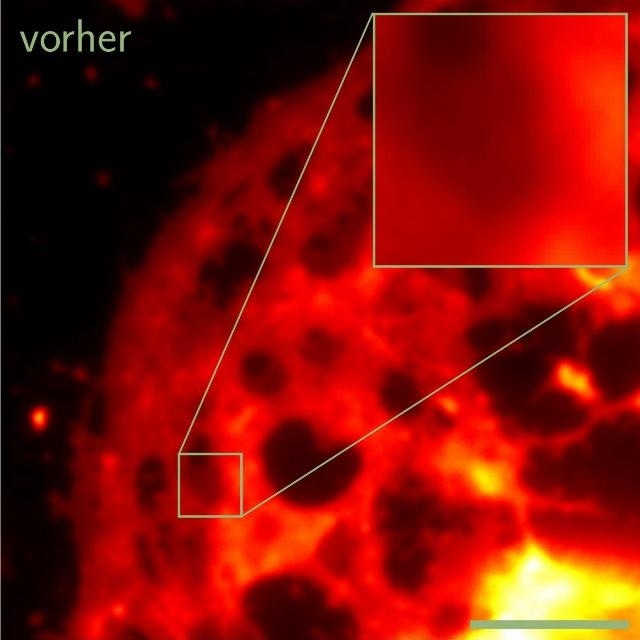Mar 25 2016
Single molecules can be observed in detail using special microscopes. However, these ultra-high resolution instruments require an image processing step to process the raw image data to obtain an image. A new open source software solution, capable of rapidly and efficiently processing such raw image data has been developed by the Members of the Biomolecular Photonics Group at Bielefeld University for an ultra-high resolution fluorescence microscope used for biophysical research.
 The images show a liver cell before and after processing the data with the software developed at Bielefeld University. (Photo: Bielefeld University)
The images show a liver cell before and after processing the data with the software developed at Bielefeld University. (Photo: Bielefeld University)
The Bielefeld physicist Dr. Marcel Müller has described this new open source software in the Nature Communications journal. The lower resolution limit of traditional light microscopy is limited by the diffraction limit to approximately one-fourth of a micrometer. However, images with a resolution lower than these physical limits can be obtained using High-resolution fluorescence microscopy. The physicists Stefan Hell, Eric Betzig, and William Moerner became the Nobel laureates for the development of this key technology in 2014 for biomedical research.
At present, structural illumination is one of the methods being explored by the researchers in this domain to obtain a better resolution. Currently, this is one of the widely used methods to present and represent dynamic processes in live cells. With a high frame rate, this method can achieve a resolution of 100 nm, it is also a non-destructive method.
The Biomolecular Photonics Group at Bielefeld‘s Faculty of Physics is involved in the application and further development of such high resolution fluorescence microscopy. For instance, the microscopy is being employed to explore the spreading mechanisms of the HI virus and the liver function. However, it is not possible to directly use the raw images acquired by this method.
The data obtained with the microscopy method require a very laborious mathematical image reconstruction. Only then do the raw data recorded with the microscope result in a high-resolution image.
Professor Dr. Thomas Huser, Head of Biomolecular Photonics Group
Until now, only a few researchers across the globe have access to the complicated mathematical procedure required to process such raw image data. An open source software solution that can be accessed by all researchers was also not available earlier. According to Huser, this as a major barrier to the widespread adoption and further advancement of the technology. This gap is now filled in by the software devised at Bielefeld.
Such universally implementable software has now been developed by Dr. Marcel Müller from the Biomolecular Photonics Group.
Researchers throughout the world are working on building new, faster, and more sensitive microscopes for structured illumination, particularly for the two-dimensional representation of living cells. For the necessary post-processing, they no longer need to develop their own complicated solutions but can use our software directly, and, thanks to its open source availability, they can adjust it to fit their problems.
Dr Marcel Müller, Biomolecular Photonics Group
The software is an open source solution available freely to the global scientific community. Several scientists, especially those in Asia and Europe, had raised request and installed the software subsequent to the announcement about its availability.
We have already received a lot of positive feedback. That also reflects how necessary this new development has been.
Dr Marcel Müller, Biomolecular Photonics Group